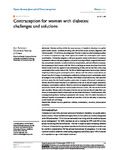Contraception for women with diabetes: challenges and solutions
| dc.contributor.author | Robinson, A | |
| dc.contributor.author | Nwolise, C | |
| dc.contributor.author | Shawe, J | |
| dc.date.accessioned | 2020-09-15T10:03:34Z | |
| dc.date.available | 2020-09-15T10:03:34Z | |
| dc.date.issued | 2016 | |
| dc.identifier.issn | 1179-1527 | |
| dc.identifier.issn | 1179-1527 | |
| dc.identifier.uri | http://hdl.handle.net/10026.1/16328 | |
| dc.description.abstract |
Diabetes mellitus (DM), the most common of metabolic disorders, is a global public health concern. Numbers are rising with 383 million adults currently diagnosed with DM and another 175 million as yet undiagnosed. The rise in cases includes increasing numbers of women of a reproductive age whose reproductive health and contraception need careful consideration. Unintended pregnancy with poor glycemic control at the time of conception increases the chance of adverse pregnancy outcomes including stillbirth, congenital abnormalities, and perinatal mortality. In order to minimize complications, safe and effective contraception is paramount for all women with DM. This is a challenge as women have been found to be reticent to ask for advice, appear to lack understanding of risks, and are less likely to be using contraception than women without DM. The World Health Organization has developed Medical Eligibility Criteria to guide contraceptive choice. Women with DM without complications can choose from the full range of contraceptive methods including hormonal contraception as the advantages of use outweigh any risk. Women with diabetic complications may need specialist advice to assess the risk-benefit equation, particularly in respect of hormonal contraception. Women should be aware that there is no restriction to the use of oral and copper intrauterine emergency contraception methods. There is a need for an integrated approach to diabetes and reproductive health with improved communication between women with DM and their health care providers. Women need to be aware of advice and services and should make their own choice of contraception based on their needs and associated risk factors. Practitioners can offer nonjudgmental guidance working in partnership with women. This will enable discussion of risks and benefits of contraceptive methods and provision of advice dedicated to improving overall health and well-being. | |
| dc.format.extent | 11-11 | |
| dc.format.medium | Electronic-eCollection | |
| dc.language | en | |
| dc.language.iso | eng | |
| dc.publisher | Informa UK Limited | |
| dc.subject | diabetes mellitus | |
| dc.subject | gestational diabetes | |
| dc.subject | contraception | |
| dc.subject | education | |
| dc.subject | preconception counseling | |
| dc.title | Contraception for women with diabetes: challenges and solutions | |
| dc.type | journal-article | |
| dc.type | Review | |
| plymouth.author-url | https://www.ncbi.nlm.nih.gov/pubmed/29386933 | |
| plymouth.volume | 7 | |
| plymouth.publication-status | Published online | |
| plymouth.journal | Open Access Journal of Contraception | |
| dc.identifier.doi | 10.2147/oajc.s56348 | |
| plymouth.organisational-group | /Plymouth | |
| plymouth.organisational-group | /Plymouth/Faculty of Health | |
| plymouth.organisational-group | /Plymouth/Faculty of Health/School of Nursing and Midwifery | |
| plymouth.organisational-group | /Plymouth/REF 2021 Researchers by UoA | |
| plymouth.organisational-group | /Plymouth/REF 2021 Researchers by UoA/UoA03 Allied Health Professions, Dentistry, Nursing and Pharmacy | |
| plymouth.organisational-group | /Plymouth/Research Groups | |
| plymouth.organisational-group | /Plymouth/Research Groups/Institute of Health and Community | |
| plymouth.organisational-group | /Plymouth/Research Groups/Plymouth Institute of Health and Care Research (PIHR) | |
| plymouth.organisational-group | /Plymouth/Users by role | |
| plymouth.organisational-group | /Plymouth/Users by role/Academics | |
| dc.publisher.place | New Zealand | |
| dc.identifier.eissn | 1179-1527 | |
| dc.rights.embargoperiod | Not known | |
| rioxxterms.versionofrecord | 10.2147/oajc.s56348 | |
| rioxxterms.licenseref.uri | http://www.rioxx.net/licenses/all-rights-reserved | |
| rioxxterms.type | Journal Article/Review |


